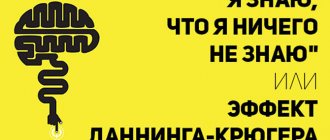Two mysterious and complex words often plunged those who heard them at an unexpected moment into a stupor.
- I have cognitive dissonance!
But what does it mean? We analyze smart words and explain them in simple language. So now let’s find out what this all means, how to remember it and use it correctly.
So, cognitive dissonance comes from two Latin words: cognitio - “cognition” and dissonantia - “dissonance”. In other words, this is some kind of internal disharmony or lack of comfort.
Meaning of the concept
Cognitive dissonance is a psychological phenomenon that involves the occurrence of some inconsistency between two cognitions. Thus, often in his actions a person has to either neglect social guidelines or sacrifice personal principles. Because of this, a certain disagreement arises between action and belief.
As a result of the onset of cognitive dissonance, a person may resort to justifying his own actions or misconceptions that run counter to generally accepted norms. Otherwise, the individual has to direct his thinking in a new direction, which would correspond to the opinions of others and reduce contradictory feelings.
Cognitive dissonance - what is it in simple words?
Many psychological concepts and terms are not so easy to understand and understand their meaning. Sometimes detailed explanation is required. This also applies to such a phenomenon as cognitive dissonance. What is this in simple words? The explanation of this concept is much simpler than it might seem at first glance.
Each person has some kind of life experience and personal opinion regarding the solution of certain situations. However, it is not always possible to solve a particular problem based on one’s own ideas. Sometimes a person goes against his own opinion, for example, to please the opinions of others, social values, or the norms of the law. This discrepancy between thoughts and actions is called cognitive dissonance.
Sometimes it happens that an individual consciously or unconsciously violates certain rules (or even commits a crime). In this case, it is important to receive justification not only from others, but also from yourself. Thus, a person begins to look for or invent moments that can mitigate guilt in order to ease internal contradiction. It is also worth noting that such contradictions can arise not only among one individual, but also at the level of the collective.
Cognitive dissonance also often occurs when a person has to make an important decision. The individual is overcome by doubts that do not go away even when the final choice is made. Mental activity for some time will be aimed at sorting through possible options and their consequences in your head.
Conducted research and experiments
All research can be divided into three main areas:
1. Enforcement behavior.
2. Decision making.
3. Application of effort.
We will review the main findings that have emerged in each area.
Example of Enforced Compliance Behavior
When someone is forced to do (publicly) something they (privately) really don't want to do, there is a dissonance between their cognition (I didn't want to do that) and their behavior (I did that).
Coercive compliance occurs when a person does something that does not align with his or her beliefs. Behavior cannot be changed since it has already been used, so it is necessary to reduce the contradiction by reconsidering the attitude towards your actions. This prediction was tested experimentally in the cognitive dissonance “Peg Turns” experiment.
Example 1
In an intriguing test taken in 1959, scientists Festinger and Carlsmith asked participants to complete a series of tasks. One of them was to turn the pegs on the board for an hour. As you can imagine, the participants' attitudes towards this task were extremely negative.
| Target | Festinger and Carlsmith in 1959 tested whether creating humans to complete a task would create cognitive dissonance through enforcement behavior. |
| Method | In their laboratory experiment, they tested 71 male students as participants to perform a series of tasks (such as spinning pegs on a board for an hour). They were then paid either $1 or $20 so that he could tell the waiting participant that the problems were actually interesting. Almost all participants agreed to go to the waiting room and announced that the experiment would be exciting. |
| results | When asked to rate the experiment, participants who were paid just $1 rated the tedious task as more fun and enjoyable than participants who were paid $20 to lie. |
| Conclusion | Paying just $1 is an incentive to lie, so dissonance arises among those who were paid $1. It could only be overcome by believing that the tasks were truly interesting and enjoyable. $20 provides a reason to turn the pegs, so there is no dissonance. |
Decision Making Example
Life is full of decisions, and decisions usually cause disharmony. Let's say you had to decide whether or not to take a job on the other side of the country and be close to your friends and family. Either way, you will experience dissonance. If you accepted the job, you would miss your loved ones. If they refused the job, they would regret the lost opportunity.
Both alternatives have their pros and cons. The problem is that the decision eliminates the possibility that you can enjoy the benefits of the unselected alternative. At the same time, it assures you that you must accept the shortcomings of the chosen alternative.
People have several ways to reduce the discrepancy that results from a decision. One thing they can do is change behavior. As noted earlier, this can be very difficult, so people use various mental maneuvers. A common way to reduce dissonance is to increase the attractiveness of the chosen alternative and decrease the attractiveness of the rejected alternative. This is called “expanding alternatives.”
Example 2
Brehm in 1956 was the first to study the relationship between disharmony and decision making.
| Target | Studying the decision-making stage |
| Method | Participants were told that they would be assisting in a multi-industry funded study. Participants were also eligible to receive one of the products at the end of the experiment to compensate for their time and effort. The women then rated the desirability of eight household products that ranged in price from $15 to $30. Products included an automatic coffee maker, an electric sandwich grill, an automatic toaster, and a portable radio. Participants in the control group were simply given one of the foods. Because these participants had not made a decision, they had no dissonance to reduce. |
| results | People in the low dissonance group chose between a desired product and a rating 3 points lower on an 8-point scale. Participants in the high dissonance condition chose between a highly desirable product and one rated 1 point lower on an 8-point scale. After reading the reports of various products, people have rated the products again. |
| conclusions | Participants in the high dissonance condition were more dissonant in addition to alternatives than participants in the other two conditions. In other words, they were more likely than participants in the other conditions to increase the attractiveness of the alternative and decrease the attractiveness of the unchosen alternative. |
Effort Example
We value more goals that required significant effort to achieve. This is probably because dissonance would arise if we put a lot of effort into achieving something and then evaluate it negatively. Of course, we could spend years of effort trying to achieve something that would be nonsense. And then, to avoid the dissonance that arises, try to assume that we really haven't spent years of effort, or that the effort has been really very enjoyable, or that it hasn't been very much effort.
In fact, it is easier for us to convince ourselves that a hard-won result is more valuable than one achieved with less effort. This method of reducing dissonance is known as justification of effort.
If we put effort into a task and it ends in failure, we experience dissonance. To reduce this dissonance, we are motivated to think that the task was a success.
Example 3
Research by Aronson and Mills in 1959 demonstrates the basic idea.
| Target | Identify the relationship between dissonance and effort. |
| Method | The students volunteered to take part in a discussion on the psychology of sex. In a "mildly embarrassed" condition, participants read a list of gender-related words such as "virgin" and "prostitute" to a male audience. In a state of "serious embarrassment" they had to read out loud obscene words and a very explicit sexual passage. In the control condition, they went straight into the main study. Then, in all conditions, they heard a discussion about sex in lower animals. They were asked to rate how interesting they found the discussion and how interesting they found the people involved in it. |
| results | Participants in the “severe embarrassment” condition gave the most positive ratings. |
| Conclusion | If you have experience that is costly, the dissonance is reduced. This helps justify the effort. |
Causes of cognitive dissonance
Cognitive dissonance can arise due to several common reasons, among which the following are worth highlighting:
- inconsistency of ideas and concepts that guide a person when making certain decisions;
- discrepancy between life beliefs and generally accepted norms in society or in a certain circle;
- the spirit of contradiction caused by the reluctance to follow generally accepted cultural and ethical norms, and especially when they run counter to the law;
- discrepancy between the information obtained as a result of a particular experience and new conditions or situation.
Hypotheses of the theory
L. Festinger's theory of cognitive dissonance is based on two main hypotheses, which are as follows:
- due to the fact that the occurrence of cognitive dissonance is accompanied by psychological discomfort, the individual will try in every possible way to overcome this discrepancy;
- from the first point we can derive the second, which states that a person will in every possible way avoid situations that could plunge him into such a state.
Festinger's theory of cognitive dissonance not only provides an interpretation and clarification of concepts, but also explains ways out of this state. In addition, the scientist considers a number of real cases, which are the most typical examples in psychology.
[edit] Hardware level
It is worth highlighting separately the situation when new information contradicts not so much accumulated experience as the architecture of the human brain in principle. As a rule, it is not caused by information coming from outside, but by the results of strong thoughts, when the brain produces a response that it itself is not able to perceive, which makes this phenomenon similar to division by zero and gives the right to consider it a bug in human development.
At-risk groups:
- matan adherents who recreate n-dimensional spaces in their minds (where n can even be infinity);
- philosophers searching for the meaning of existence;
- physicists developing theories for the construction of space-time;
- a special risk group is any person above 150 who is trying to understand infinity.
Awareness of such concepts, for which the human mind is not initially adapted, leads to the fact that the patient with a high degree of probability flies into the atral and, with an even greater probability, never returns from there. However, basic motor skills are retained (walking, eating, defending doctoral dissertations), which often makes it impossible to immediately identify victims and send them for treatment.
The essence of the theory
The first thing worth noting is the fact that the theory of cognitive dissonance belongs to the category of motivational ones. This means that this state is decisive in the behavior of the individual. We can say that it is ideas and beliefs that largely influence a person’s actions, as well as his life position. Thus, knowledge cannot be interpreted only as a set of certain facts. These are, first of all, motivational factors that determine human behavior both in everyday life and in non-standard situations.
The concept of cognitive dissonance combines two categories. The first of them is intelligence, which is considered as a set of certain beliefs and knowledge, as well as attitudes towards them. The second is affect, that is, the reaction to pathogens and stimuli. At the very moment when a person ceases to find a connection or feels internal contradictions between these categories, a state of cognitive dissonance occurs.
The process itself is inextricably linked with past events and experiences of the individual. So, having committed a certain act, a person may begin to repent or experience remorse. Moreover, this can happen after a significant period of time. Then the individual begins to look for an excuse for his action or some facts that can mitigate his guilt.
How to reduce dissonance?
The state of cognitive dissonance causes psychological discomfort, which the individual, quite naturally, tries to get rid of (or at least somewhat reduce the unpleasant sensations). There are several ways to achieve relief from a contradictory condition, namely:
- change the line of your behavior (if you feel that you are doing wrong, or are acting contrary to your beliefs, you should direct your efforts in the opposite direction, if this seems possible in this particular case);
- convince yourself (meaning the search for justification for your actions in order to reduce their guilt or even make them correct in your understanding);
- filter information (in order not to feel internal contradictions, you should perceive only positive data, and not take all negativity seriously or avoid it altogether);
- take into account all the information and facts about the current situation, form an idea about it, and then build a new line of behavior that will be considered the only correct one.
[edit] Examples
| ◄ ► |
Example in MLP Collective CD. On a KAMAZ through a corn field Song about the subject
- In the USA, Caucasian is synonymous with the word White, and therefore clearly black Abkhazians are a hard break from the mold for them. The same applies to Ethiopian Jews.
- The reaction of an ardent homophobe who read Freud's works on latency.
- Winnie the Pooh visiting the Rabbit
- Smeshariki: issue 14, episode “It can’t be.”
- In Spec Ops: The Line, from the second half of the game, a definition of cognitive dissonance appears among the tips shown during loading. By that time, both the main character and the player himself had time to catch this same cognitive dissonance (at least from the same “advices”).
- We all remember the reaction of a patient who begins to leak information to his interlocutor in a dispute. Since FGM does not allow you to check the data coming to Moscow or agree that “I’m wrong,” thereby changing the information in your head, the patient tries to get rid of the flow of information from the outside.
- An excellent generator of cognitive dissonance in Moscow homo sovieticus is this or this song.
- Cognitive harmony is a response to cognitive dissonance.
- The question “can you find a cigarette?”, supported by a gesture that is usually used when asking “what time is it?” (pointing the finger of the right hand to the wrist of the left).
- You bite into a cucumber and feel the taste and smell of orange.
- Some people get embarrassed when a sentence suddenly ends in a different way because they are obese
- Psychologists conducted an experiment on kindness and its acceptance by patients: between a greedy person, an altruist and two like them, everyone always chose someone like everyone else as a partner.
- Childhood cognitive dissonance (most likely due to mitolisd)
- Musical cognitive dissonance: the matured group Tokyo Hotel returned from a long sabbatical having changed their musical style and image.
- Also:
| - Sivka-burka, prophetic kaurka! Stand before me like a leaf before the grass! “Ivan, I’m just a horse, and your insinuations about the space-time continuum give me a feeling of deep cognitive dissonance. - What? “Well, that’s roughly what I was trying to convey to you.” |
- And a little poetry:
| Having traveled around the world a little, I learned the rule, which, in cognitive dissonance, in other places they give in the fuck. |
- Rhyme for children:
| It was in December, the third of April. It was dry in the yard, knee-deep mud. A tall citizen of short stature was walking across an iron bridge made of pine planks. Curly, no hair, thin as a barrel. He writes a letter to his son: “Dear daughter! I'm alive and well, I'm lying in the hospital, I'm fed up and want to eat. Come from the capital, I don’t want to see you.” |
- Mystery:
| Two crocodiles were flying. One is green, the other is to the north. What is my grandmother's name? |
How to avoid dissonance
Since the phenomenon of cognitive dissonance is associated with discomfort and psychological stress, many prefer to prevent this condition rather than deal with its consequences later. One of the most accessible ways to achieve this is to avoid any negative information that may contradict your personal beliefs or the current situation. This method fits into the concept of psychological defense, which was developed by Sigmund Freud and later developed by his followers.
In the case where the occurrence of cognitive dissonance could not be avoided, its further development can be combated. To do this, additional elements are introduced into the cognitive system, which are designed to present the current situation in a positive light. In this case, you need to ignore or in every possible way avoid those sources of information that can return you to the initial state.
One of the most common and accessible ways to cope with dissonance is to accept reality and adapt to it. In this regard, it is worth convincing yourself that the situation is acceptable. In addition, if the phenomenon is long-term, then psychological work should be aimed at changing one’s own beliefs
Mind tricks to combat dissonance
Surprisingly, the wisely designed brain itself figured out how to deal with dissonance: these are active methods, methods of avoidance, and methods of reducing negativity. Under the influence of consciousness, a person uses the following techniques to reduce psychological stress:
- abandons past beliefs, which is sometimes better to do if they contradict general norms;
- convinces himself by adopting positive thinking techniques to find positivity in a hopeless situation;
- avoids unwanted events, gains experience in order to prevent them in the future;
- eliminates uncomfortable facts.
Such techniques, prompted by consciousness, are available to everyone, you just have to listen to your intuition.
Cognitive dissonance: examples from life
In real life, quite often you can encounter such phenomena that cause a feeling of inconsistency or inconsistency of beliefs with the real situation. This is cognitive dissonance. Their examples are quite numerous.
The simplest example is a gold medalist and a C student who entered the university. It is quite logical that teachers expect high results and a decent level of knowledge from the first, but do not have much hope for the second. However, it may turn out that an excellent student will answer the question very mediocrely and incompletely, while a C student, on the contrary, will give a competent, meaningful answer. In this case, the teacher experiences cognitive dissonance due to the fact that his beliefs turned out to be inconsistent with the real situation.
Another example given by psychologist A. Leontyev illustrates the desire to reduce discomfort. Thus, imprisoned revolutionaries were forced to dig holes as punishment. Naturally, the prisoners found this activity unpleasant and even disgusting. To reduce the feeling of psychological discomfort, many gave their action a new meaning, namely, causing harm to the current regime.
Also, cognitive dissonance can be considered in relation to people who have bad habits (for example, smokers, or those who abuse alcohol. It is quite natural that they all sooner or later realize the harm of these phenomena for their body. In this case, there are two scenarios. Either the individual tries by all available means to get rid of a bad habit, or begins to look for excuses for himself, which in his mind can outweigh the possible harm that will be caused to health.
Another example also relates to a typical life situation. So, for example, you see a beggar on the street who is asking for alms, but by his appearance you can tell that he does not really deserve the money or does not need it that much (or maybe he will spend money not on food or medicine, but on alcohol or cigarettes). Nevertheless, under the influence of your life principles or moral standards, you cannot pass by such a person. Thus, under the guidance of social principles, you do what you do not want.
Sometimes it happens that before an important exam, a student simply does not prepare for it. This may be due to laziness, health conditions, unforeseen circumstances, and so on. Thus, understanding his responsibility for the result and realizing the possible consequences, the individual, nevertheless, does not make any attempts to learn the notes.
Girls who strive to lose weight and torment themselves with diets are often exposed to cognitive dissonance. If at this time they want to eat, for example, a cake, then this will contradict their goals and general ideas about proper nutrition. There are several possible solutions to the problem here. You can continue to insist on your own and deny yourself sweets, or you can stop the diet altogether, making sure that you already look good. You can also make yourself a one-time indulgence, which will later be compensated by fasting or physical activity.
Conclusion
Many scientists and psychologists have studied the issue of cognitive dissonance. It is especially worth paying attention to the works of Leon Festinger, as well as Sigmund Freud and his followers. Their theories are the most complete and contain not only information about the phenomenon itself and its causes, but also about ways to solve the problem.
It is worth noting that the theory that describes the phenomenon of cognitive dissonance relates to motivational ones. The contradiction that arises as a result of the discrepancy between beliefs and desires and real actions largely influences what the individual’s behavior will be in the future. He can come to terms with the situation and try to reconsider his ideas, which will somewhat reduce the state of dissonance, or he can resort to attempts to explain or justify his behavior, avoiding real data and facts (protecting himself from the outside world).
To avoid a state of cognitive dissonance, you should avoid contradictory states and information that contradicts your beliefs. In this way, you can protect yourself from internal contradictions that arise from the need to act contrary to your desires and beliefs.
[edit] See also
- Buthurt
- Wash your brain
- Schizophasia
- What were you smoking?
- Division by zero
- Break pattern
- I don't understand shit
- Mutually exclusive paragraphs
| [ + ] Cognitive dissonance - material from the archives of the Ministry of Health of Lurkomor. | |||||||||||||||
| |||||||||||||||











